Author’s note: A previous version of this article was presented to the 44th Annual Meeting of the Psychonomic Society, Vancouver, BC, November 8th, 2003. Thanks for assistance from Robert A. Baker, Professor Emeritus, University of Kentucky, and Jennifer Krischer, Jess Leuschen, Jim West, and Geoff Andersen, U.S. Air Force Academy.
The Descriptions of alien faces historically reported by UFO abductees are almost boringly uniform. Long before “close encounters” became a catchword in the ufologist’s vocabulary, self-proclaimed UFO abductees described their abductors as bulbous-headed humanoids equipped with oversized, wraparound eyes, vertical double-slit nostrils and gray skin. Is there another explanation for this uniformity of features besides the most obvious — that it is a description of an actual alien race?
Reports of Aliens
The archetypical alien face most commonly reported by abductees is usually recalled while the victim is in a hypnagogic half-dream state, or else under hypnotic regression. Figure 1 below shows a typical face drawn by a self-claimed UFO abductee who was interviewed by psychologist Robert A. Baker in 1993. Figure 2 shows another typical alien face drawn by one of my abductee clients. In 1979, my colleague Richard Coffman and I published a study of the bodily dimensions of reported aliens.1 Our random sample of 30 reported aliens revealed that 100% were humanoid in shape and stood at a median height of 155 cm (60 inches )— a height close to that of the average woman. In addition, 80% of our sample had the typical UFO face: prominent, somewhat diagonally oriented eyes, double-slit nostrils, and little or no evidence of a mouth.
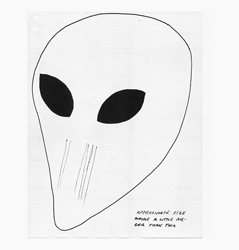
FIGURE 1: a typical face drawn by a self-claimed UFO abductee.
Our most telling finding was that most of our alien encounters were reported by subjects who admitted to either being in a hypnagogic state (that nether region between sleep and wakefulness) at the time, or else they were experiencing hypnotic regression. For instance, the world-famous abduction of a New Hampshire couple, Betty and Barney Hill (Betty was once a neighbor of mine) was not reported by them immediately after it happened. They recalled the abduction several weeks later, and then only when prompted to do so under the influence of hypnotic regression.2
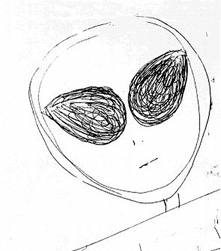
FIGURE 2: another typical alien face drawn by one of Malmstrom’s abductee clients.
The Inborn Visual
Recognition Template
Many newborn animals are equipped with inborn visual recognition templates. It has been well over a half century since ethololgist Niko Tinbergen found that newly hatched chicks would automatically cower from shadow patterns that resembled predators (such as hawks). These same chicks ignored shadow patterns that matched nonpredators (such as geese).3
Human facial recognition is a highly specialized ability, and it seems to be pre-wired before birth in specific visual processing areas of the brain. However, the human newborn ability to distinguish between familiar and unfamiliar faces does not develop in infants until about two months of age.4 Up to that time, an infant will respond favorably to nearly any face, familiar or unfamiliar, normal or bizarre, mother or Halloween mask. Of course, all these human-type faces seem to share two quite generalized and nonspecific features, namely a pair of eyes and a nose.

FIGURE 3: Dual “pupil” schematic which receives the most attention from newborn infants (after Hess, 1975).
The singular feature that seems to grab the baby’s attention is the presence of two large horizontally arranged spots or “eyes.” Infants seem to ignore one or three spots. Furthermore, the pioneer pupillometry researcher Eckhard Hess reported that infants paid especially close attention to the size of the “pupils” within these eyes. Larger pupils attracted more infant attention than smaller ones.5 The visual presentation that gathered most infants’ attention was the dual large-pupil schematic shown in Figure 3.
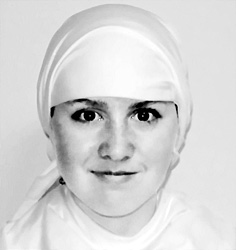
FIGURE 4: A female “Protoface” (after Nelson, 1994).
The Prototype Female Face
Rather than using spots or schematic pupils, I.W.R. Bushnell utilized a “prototype” young female face, one for which the hair and ear outline of the face was covered with white cloth, such as that shown in Figure 4.6 Newborn infants seemed not to discriminate between these prototype faces, although they afterwards quickly learned to discriminate between faces with the added cue of a hair outline. However, the ability to recognize this prototype hairless and earless face is reportedly located in the hippocampus, a noncortical area of the brain.7 An infant’s inborn ability to recognize a generalized face is apparently evolutionarily quite primitive. According to this research, the infant begins with the prototype female “protoface” pre-wired visually into the midbrain, and then later utilizes the cortical areas to add additional visual recognition cues, such as the hairline and ear.
Newborns Have Quite Limited Visual Capabilities
Within the literature of neonatal vision there is considerable disagreement over whether the neonate is born severely myopic (nearsighted) or hypermetropic (farsighted). Regardless of the conflicting claims, it is generally reported that a neonate will pay attention to objects only 7–25 cm (3–10 in) in front of their eyes, and they will generally ignore any activity outside this range. However, the infant’s range of attention increases rapidly and will expand to perhaps a range of 1 meter or greater in as little as 1–2 days after birth.8 The newborn infant’s vision is also reported as being substantially clouded, as if he or she is peering through fog.
Regarding infant color perception, neonates (as measured by the time they focus attention) are also unable to discriminate between colors within the same display. Their vision seems to tend toward discrimination between shades of gray. To the newborn, says Atkinson, “color discriminations are either weak or absent.”9
Finally, Atkinson reports that newborn astigmatism is “very common.”10 Adults are quite aware that astigmatism is most annoying and gives the impression of visual “smearing” of an image. However, newborn astigmatism seems to be a perceived smearing only in the periphery of all images outside the central cylinder of focus.
Seeing Faces That Are or Are Not There
Prosopagnosia, an inability to recognize faces, is both a well-documented and fascinating medical condition. It is frequently preceded by bilateral brain damage or insult to the areas surrounding the calcarine fissure, an area that overlaps both the parietal and visual cortex. Anatomically, the cortical fusiform gryi and the midbrain structures are also most certainly involved.11 Prosopagnosia involves not only the inability to see or recognize faces, but sometimes, and just as importantly, as neurologist Oliver Sacks illustrates in his charming book The Man Who Mistook His Wife for a Hat, often involves the perception of faces that aren’t there.12
Human facial recognition occurs at a surprisingly coarse level of visual processing, a crude contrast sensitivity range of around 3 cycles/ degrees spatial frequency, precisely the region where the human visual system also has its highest contrast sensitivity. Harmon and Julesz, both of Bell Labs, reported that faces are remarkably recognizable under these so-called degraded or otherwise blurry, limited environments. Moderate blurring acts as a low-pass filter and often actually improves facial recognition.13
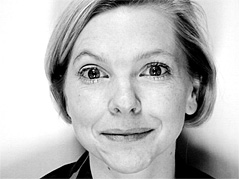
FIGURE 5: Unprocessed young female face.
What is the First Thing a Newborn Baby Sees?
Obviously, one of the first and most frequent things a baby sees and commits to memory is its mother’s face. In Figure 6 of this article I have transformed the young female face of Figure 5 into the kind of face that may be presumed to be seen by the newborn. The transformed face is shown at the intimately close distance that we might expect an infant to see. The reader is invited to compare the “neonatally” perceived face to a “typical” alien face as shown in Figures 1 and 2. I believe this demonstrates that there is an innate template face that approximates the typically reported face of a UFO alien.
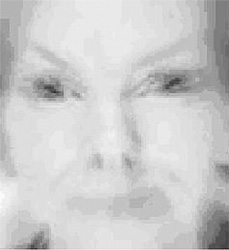
FIGURE 6: A mother’s face as it might be seen by a newborn (processed to represent a contrast sensitivity of 3 cycles degrees when viewed at a visual angle of 50°, with simulated radial astigmatism and an extremely shallow (1 cm) depth of focus.
Transforming a Mother’s Face into a UFO Alien Face
I enlisted the assistance of a young healthy Caucasian female about age 30, a representative age for a mother of a newborn. She was photographed with direct frontal lighting to reduce shadowing and also to minimize her hairline. Her digital photo was then transformed in gray scales to a coarseness of about 150 pixels across a field of 50° of visual angle. This operation simulated a 2-dimensional Fourier transform of about 3 cycles/degrees of visual angle, the same region where the human visual system has its highest contrast sensitivity. Extremely shallow depth of focus and astigmatism were also simulated by smearing the periphery. Finally, her face was then clouded and further smoothed by blurring to eliminate the high contrast edges introduced by the coarse pixilation process of step one. The resulting face approximates the face a newborn baby might perceive immediately after birth (Figure 7).
The facial transformation from mother to alien proceeds in these steps. The first processing (Figure 6) seems to yield a face in which the eyes and associated pupils become the most prominent feature. The smearing of the periphery and the simulation of an extremely shallow depth of focus yields a rather startling effect. The eyes seem to slant diagonally upwards and assume prominence. Second, the nostrils begin to lose their roundness and tend to be seen as vertical slits. Third, the mouth becomes less distinguishable.
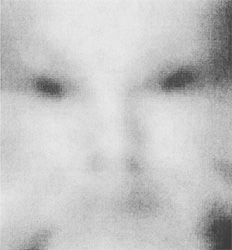
FIGURE 7: The mother’s face immediately after birth. Cloudiness was added to Figure 6 and the image was coincidentally smoothed to remove the residual high spatial frequencies. Squinting at the picture enhances the “UFO alien” effect even more.
The final process (Figure 7) was accomplished by inserting a smoothing function that serves as an additional second low-pass spatial frequency filter, passing only the 3 cycles/degrees visual information. This transformation makes the mouth features still more indistinguishable but paradoxically often improves facial recognition. In fact, the transformation to an alien face becomes even more extreme if the observer squints at the picture. The blurring caused by squinting acts as an additional low-pass filter.
A Little Green Woman?
Similar results can be produced by transforming the prototype female faces published by both Nelson and Atkinson.14 In fact, these transformation results could be used to support the claim that ubiquitous UFO alien faces are those of Little Green Women rather than Little Green Men.
The power of visual imagery is often confused for visual reality. This confusion is understandable, as visual imagery frequently occupies and competes for the same regions of the visual cortex and subcortical regions as visual perception itself. The competition between visual and mental images seems to be at its greatest during hypnagogic and dream states, precisely the awareness regions where these two processes merge.15 Hence, it would be expected that the alien face perceived in hypnagogic dreamlike states is also produced from the same primitive facial recognition template. Further investigation is warranted. Like the predator-recognition system of the newly-hatched chick reported by Tinbergen,16 it would be no surprise if a template of a female UFO-type face is also preprogrammed into our human brains. The infant’s immediate recognition of a prototype female face, and especially that of its mother, is arguably an important survival advantage.
References & Notes
- Malmstrom, F. and R. Coffman. 1979. “Humanoids Reported In UFOs, Religion, and Folktales: Human Bias Towards Human Life Forms?” In: Haines, R. (ed). UFO Phenomena and the Behavioral Scientist. Metuchen, New Jersey: The Scarecrow Press, 60–88.
- Fuller, J.G. 1965. The Interrupted Journey. New York: Dial Press.
- Tinbergen, N. 1951. The Study of Instinct. London: Oxford University Press.
- Atkinson, J. 2000. The Developing Visual Brain. Oxford: Oxford University Press.
- Hess, E. H. 1975. The Tell-tale Eye. New York: Van Nostrand Reinhold.
- Bushnell, I.W.R. 1982. “Discrimination of Faces By Young Infants.” Journal of Experimental Child Psychology, 33, 298–308.
- Nelson, C.A. (1994). “Neural Correlates of Recognition Memory During the First Potential Year of Life”. In: Dawson G., and K. Fisher (eds) Human Behaviour and the Developing Brain, New York: Guilford Press, 269–313.
- McCarthy, G. 2000. “Physiological Studies of Face Processing In Humans.” In: Gazzaniga, M. S. (ed.-in-chief). The New Cognitive Neuroscience, 2nd edition. Boston: The MIT Press.
- Atkinson, 2000.
- Atkinson, 2000.
- McCarthy, 2000.
- Sacks, O. 1998. The Man Who Mistook His Wife For A Hat and Other Clinical Tales. New York: Touchstone Books.
- Harmon, L. and B. Julesz. 1973. “Masking In Visual Recognition: Effects Of Two-dimensional Filtered Noise.” Science, 180, 1194–1197.
- Atkinson, 2000. Nelson, 1994.
- Baker, R. A. 1996. Hidden Memories: Voices and Visions From Within. Buffalo, New York: Prometheus Books.
- Tinbergen, 1951.
This article can be found in
volume 11 number 4
Ernst Mayr, 1904–2005
this issue includes: Close Encounters of the Facial Kind; The Da Vinci Code Cult; The Dream World of William Dembski’s Creationism; John of God; How The Human Got Its Mind…
BROWSE this issue >
ORDER this issue >
This article was published on February 3, 2011.







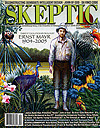








“But how do you explain people around the world that in most instances do not know about aliens and are not interested in them resulting deeply traumatized….
They exist.”
Please provide actually evidence that those reporting have not been influenced by the decades of UFO culture that has spread with globalization. All you’ve given us is a rhetorical question designed to support a conclusion.
“Interesting, except that the now-familiar ET face has NOT been constant throughout the history of UFO claims”
Nowhere does the author suggest that this would explain all alleged visitations or variations in details. It isn’t necessary that there be only one cause or influence on the portrayal of the alien visitor. Indeed, it would seem rather obvious that cultural influences would act along with any source in childhood memory.
Good hypothesis….but there are accounts of very different kinds of aliens ranging from little grey to insectoids to orbs of light to sticks….It could be that they are archetypes..
But how do you explain people around the world that in most instances do not know about aliens and are not interested in them resulting deeply traumatized….
They exist….
Interesting, except that the now-familiar ET face has NOT been constant throughout the history of UFO claims. For example, see this drawing by Joe Nickel showing a timeline of the many various supposed alien “types”: http://farm3.static.flickr.com/2485/3814088694_bdd019fa84_o.jpg
Lots and lots of variation there. But after Whitley Strieber and Budd Hopkins became famous, they more or less “standardized” the genre.